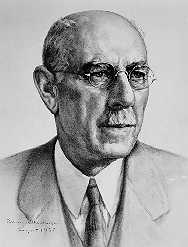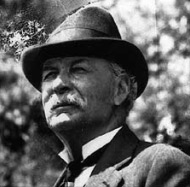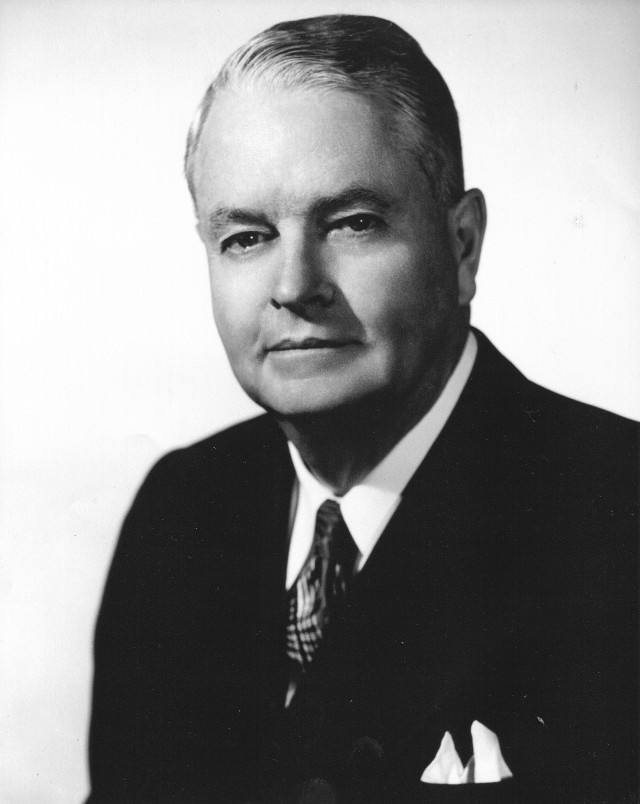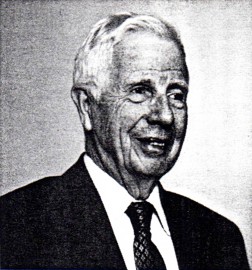Past Leaders
of the Los Angeles Section
American Society of Civil Engineers
|
Since its formation in 1913, the Los Angeles Section of the American Society of Civil Engineers has been blessed with a long list of notable and respected civil engineering professionals, many of whom have gone on to serve important roles of distinction in the public and private sectors and in ASCE Society at the national level. Section members who have served as both Section and Society President include:
| |
| In addition, the LA Section has provided numerous committee members, chairs, directors, and vice presidents for service to the ASCE National organization. Since the founding of the Section, there have been 100 Section Presidents who have served the Section membership with distinction and leadership. Due to space limitations, biographies of all these outstanding leaders could not be included but profiles and interesting anecdotes of just a few noteworthy past ASCE Los Angeles Section Presidents have been pulled from the ASCE Section Archives to be showcased in celebration of the Centennial (100th Anniversary) of the ASCE Los Angeles Section. | |
  |
Joseph Barlow LippincottThe LA Section's first president, formally sworn in on January 5, 1914, after the Section formation in 1913, was Joseph Barlow Lippincott, a hydraulic engineer who served as a construction manager on the Los Angeles Aqueduct and aided in construction of major water supply projects throughout CA, AK, HI and Mexico. |
 | William MulhollandThe Section's third president in 1916 was the noted engineer, William Mulholland. He was responsible for building the City of Los Angeles' water infrastructure and providing a water supply that allowed the city to grow into one of the largest in the world. Further, Mulholland supervised the building of the Los Angeles Aqueduct, a 233-mile (375 km)-long system that still moves water from the Owens Valley to the San Fernando Valley today. |
 | Samuel Brooks MorrisBorn in Los Angeles on August 24, 1890, to B. Samuel and Elizabeth (Shoemaker) Morris. The youngest of three brothers, Sam went through the high school grades at the vocational and preparatory school, Throop Polytechnic Institute, founded in 1891 by Amos G. Throop, which became the California Institute of Technology in 1921. Upon graduation from Throop in 1907, he took a summer job with Greene & Greene, a residential architectural firm, mostly doing tracings. As a result of that experience, Morris decided on a career in civil engineering and enrolled at Stanford University, receiving an AB in Civil Engineering in 1911. At that time, the Bachelor of Arts was the only degree offered by Stanford, but years later, he was awarded an honorary doctorate by the University of California. |
|
Upon graduation from Stanford, Morris returned to Pasadena and obtained a job with the North Pasadena Land and Water Company, for which his father was a director, and for a short time drew water system maps and prepared an appraisal of the system, while also working on park and water development projects for the City of Pasadena. After a short time, he was hired by the city to do an appraisal of the three water companies which were selling water to city residents and which were being considered for acquisition by the city, the Pasadena Land and Water Company, the Lake Vineyard Land and Water Company, and the North Pasadena Land and Water Company. In 1912, the city passed a $1.25 million bond issue and purchased the three companies, which became the Pasadena Water Department. A few months later, when the city engineer resigned, Morris was appointed to that position, which he held for the next 22 years under various titles ranging from "chief engineer" to "general manager." During the years 1912 to 1934, Morris oversaw the construction of many improvements to the city's water system, as well as construction of electrical power generation and transmission facilities for the city. One of the most notable of his projects was the design and construction between 1932 and 1934 of Morris Dam, named in his honor, on the San Gabriel River in the mountains above Pasadena. Upon completion in 1934, the dam was dedicated by former U.S. President Herbert Hoover. In 1935, Sam Morris accepted an appointment at Stanford Univerisity as professor and executive head of the Department of Civil Engineering and was appointed dean of the School of Engineering in 1936, succeeding Theodore Hoover, the brother of Herbert Hoover. While in Palo Alto he served as chairman of that city's Board of Public Works. He served as dean at Stanford until 1944 when he accepted an appointment as general manager and chief engineer of the Los Angeles Department of Water and Power, a position he held until his retirement in 1955. Sam Morris' legacy has lived on through his descendants. One of his two sons, Brooks T. Morris, and his grandson, John Morris, also chose civil engineering as a profession, and became members of ASCE. John Morris is a water resources engineer and served as the Los Angeles Section's President in 2007, as well as representing his community, San Marino, as that city's representative on the Board of Directors of the Metropolitan Water District. | |
 |
Trent R. DamesTrent R. Dames graduated from the California Institute of Technology in 1933, and received his M.S. in Civil Engineering from the Institute in 1934. He started his career in the field of soils mechanics when this field was relatively young, and contributed materially to the rapid progress which this field of engineering has experienced. His early experience was with consulting firms and with the U.S. Bureau of Reclamation.In 1938, with William W. Moore, and Trent's wife as secretary, Trent founded the firm of Dames and Moore in a one-room office in Los Angeles. From these beginnings, by 1964 the firm operated in the field of applied earth sciences from ten offices, covering the United States. In 1999, when Dames & Moore was acquired by URS for $600 million, it was one of the largest engineering and construction services firms in the world with over 7,800 employees and offices in more than 30 countries. |
|
The ASCE Trent R. Dames and William W. Moore Fellowship was established in 1990 by Dames & Moore for the purpose of advancing the science and profession of engineering and to enhance the overall welfare of mankind. The income of the $100,000 fund provides for the exploration of new applications of geotechnical engineering or the earth sciences to social, economic, environmental and political issues.In 1995 Trent established the Fund for the Heritage of Civil Engineering at the Huntington in San Marino with an endowment of $500,000. Trent served as President of the Los Angeles Section of the American Society of Civil Engineers in 1953, and also served on many important committees of the Section before and after. On the national level, he served as a member of the National Board of Direction and again was active on many committees. In October, 1962, he was named as Engineer of the Month in the "Engineer of Southern California." For the Los Angeles Section's 50th Anniversary Celebration in 1964, Trent agreed, at the request of Section Past-President C. Martin Duke, to write the Section History. Here is what Trent said about his introduction to the Section's history, which he presented at an all-day meeting of the Section in May, 1964: | |
|
"When last year's President, Martin Duke talked me into writing the Section History, he failed to tell me that this task had been assigned twice before, once in 1937 and again in 1953. In each case the "historian" wiggled off the hook after discovering what was involved. You see, the Section's records consist of 20 standard file drawers full of paper. However, Martin was a better fisherman than his predecessors, and so with the help of his able secretary of many years, Miss Kathleen Christie, the 20 filing drawers to a text of some 20,000 words was reduced down to a brief 8 page document highlighting every year or two of Section activity." | |
 |
William J. (Bud) CarrollBud Carroll served as Chairman and Chief Executive Officer of Montgomery-Watson , Pasadena, CA, which became MWH Global in 2001. President of the Los Angeles Section in 1967, and national President of the American Society of Civil Engineers in 1989, he was also the first US President of the World Federation of Engineering Organizations, in recognition of which he was awarded the Hoover Medal in 1994. Mr. Carroll received the Sustained Achievement Award of the Renewable Natural Resources Foundation for his contributions to sustainable development and his global leadership in water and wastewater projects. The following article is drawn from his remarks at an international conference in Moscow on science and engineering. |
|
"Sustainable Engineering for Cities," by William J. Carroll AAES/ASEE Newsletter, January 2001 "Environmental and sustainable development concerns are now prevalent throughout the world and considerable emphasis is being placed on them by national governments. Many governments are setting national strategies for attaining sustainable development and are giving considerable attention to the long-term consequences of their actions. They are bringing into the planning cycles such concepts as life-cycle analysis, risk versus benefits analysis, impact assessments, recycling and reuse of materials, and pollution prevention. It is also necessary that cities develop similar strategic plans in developing their industrial and manufacturing bases, so that industries that are attracted to the city enhance the city's economic well-being, but do not adversely impact the economic health of the city. As part of a city's plan, a framework has to be developed within which industry understands its responsibility to employ technologies that are both clean and resource-efficient. Its products must be safe in their intended use, efficient in their consumption of energy and natural resources, and can be recycled, or disposed of safely. There is increasing evidence that industry is accepting this mandate from governments and people. The report, "Technology for a Sustainable Future," prepared by the US National Science and Technology Council, states that "one major change will be in the nature of environmental technology itself. The past focus has been largely on controlling releases and cleaning up pollution that is already in existence; building scrubbers that remove sulfur dioxide from a smokestack, for example, or cleaning up waste sites that are already contaminated. Increasingly, environmental technology is being designed and deployed to avoid pollution altogether. Energy systems will shift toward clean fuels....Manufacturing firms will increasingly adopt products and processes designed from the outset to minimize the use of raw materials and the output of pollutants. Industrial development is very important to cities and they must work in partnership with industry to bring this development about. Industry has to recognize that cities must integrate very complex issues dealing with social, economic, environmental and political conditions. Cities must be concerned with the health problems created by inadequate infrastructure to handle the treatment and distribution of water and the disposition of domestic sewage and industrial waste. At one time these functions were basically municipal functions, but there is now a major trend toward privatization, wherein these facilities are designed, constructed, operated, and owned by private enterprises. In planning its future infrastructure, cities must recognize the rapid changes occurring in technology. In my field, which is water and waste water, we are doing research continually on treatment processes, and have been concentrating on membrane technologies, such as micro and ultra filtration and reverse osmosis. They are very effective in removing microbiological contaminants, viruses, and such difficult protozoa as giardia and cryptosporidium. In the near future we will have the ability to recycle our waste water back into our potable water systems in a safe manner." | |
 |
H. George OsborneH. George Osborne was born on December 7, 1915, in Penticton, British Columbia, Canada (just north of the U.S./Washington State border). His family moved to the United States and settled in the Fullerton, California area where he attended elementary and high school. He obtained a B.S. degree in Civil and Mechanical Engineering in 1942 from California Institute of Technology. Osborne studied Naval Science at Harvard University in 1942 and studied Diesel Engineering at Cornell University in 1943. He served on active duty in the U. S. Navy from 1942 - 1946 and retired with the rank of Commander. After World War II ended, he remained as an reserve Naval officer in the Civil Engineering Corps and served as Commanding Officer, Construction Battalion, Division 11-7, in Santa Ana, California from 1957-60. Among his ex-Navy pals he was popularly known as "the Gray Fox". |
|
H. George Osborne was a Registered Civil Engineer in the State of California and held Registration Certificate No. 7188. Osborne served as the third President of the newly formed Orange County Branch of ASCE in 1954-55, and also served as Vice President of the Los Angeles Section in 1963-64 and was President in 1981-82. In the mid-1980's, Osborne served as Chairman of the Branch's History and Heritage Committee. He also served as President of the Orange County Engineers Club in 1966. In 1994, H. George Osborne was nominated for the ASCE Civil Government Award and received the Zone IV, 1994 Government Civil Engineer of the Year Award later that year. In the Nomination Documents it was stated that: "Probably his three greatest accomplishments have been the organizing of the Environmental Management Agency of the County of Orange, and then managing that Agency, and leading the efforts of the Counties of Orange, Riverside and San Bernardino, California in securing from Congress of the United States the funds to create major flood control facilities along the Santa Ana River within those Counties. Osborne, who was known as "HGO" within County office circles, was appointed by the Orange County Board of Supervisors to the position of Chief Engineer of the Orange County Flood Control District (OCFCD) in 1955. He was known as a disciplined engineer, a demanding mentor, and a politically astute administrator. As Chief Engineer, he spearheaded the successful 1956 flood control bond election, a $43 million financing program. This bond issue was the financial backbone under which the countywide system of flood control channels was constructed. Implementation of the program allowed residential and commercial development of otherwise flood-prone areas of Orange County. In 1974 Osborne was selected by the Board of Supervisors as the first Director of the new Environmental Management Agency(EMA) which consolidated the former departments of Planning, Building, Flood Control, Roads, Surveyor, Solid Waste, Water Pollution, Harbors, Beaches and Parks into a single unit of management reporting directly to the Board. Osborne retired from the County in 1980, but was never inactive during his retirement. He served from 1981 to 1999 as Executive Director of the Santa Ana River Flood Protection Agency (a consortium of public agencies dedicated to securing political support for completion of the Army Corps of Engineers Santa Ana River Mainstem Project as authorized by the Congress in 1988). He was appointed to the Orange County Planning Commission by the third district supervisor and eventually served as commission Chairman. Later he was appointed to the Board of Directors of the Orange County Water District (OCWD) representing the City of Fullerton. Eventually, he served as the OCWD's Chairman. H. George Osborne passed away on January 12, 1999, in Fullerton, California. | |